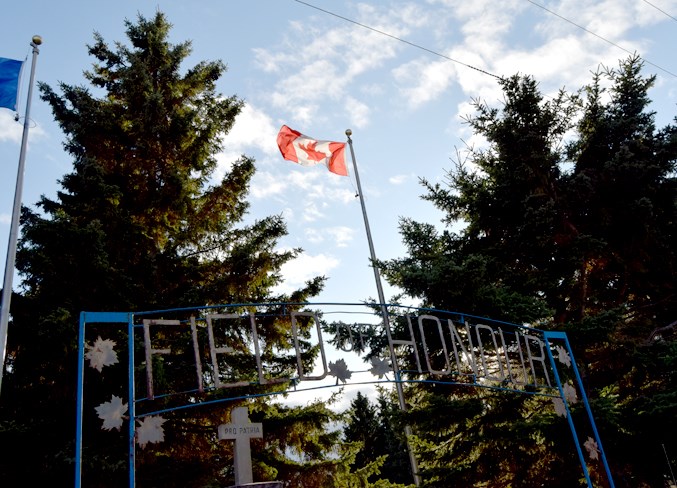Every year the Barrhead Royal Canadian Legion honours the deceased members of Canada’s Armed forces by placing a Canadian flag on their graves.
Herman Barkemeyer, 86, who is one of four people tasked with planting the more than 200 flags at more than 20 area cemeteries, said he is not sure how much longer he will be able to continue the task.
Barkemeyer is a 10-year veteran who served in both the Royal Canadian Airforce and the Canadian Army with the Princess Patricia’s Canadian Light Infantry, including a rotation during the Korean War.
The other people are Barkemeyer’s wife Inga and Legion members John Schroder and John Tiemstra.
“Every year it is getting harder and harder to do,” Barkemeyer said, noting all the members on the flag-planting committee are seniors.
The Barrhead Leader spoke to Barkemeyer a few days after the trio completed placing the flags on Oct. 18 during a tour of the Field of Honour, St Anne’s Catholic Cemetery and Belvedere Community Church Cemetery.
In addition to the flags, the Legion also places wreaths at the front gate of every cemetery.
Barkemeyer said the tradition of honouring veterans’ graves began in about 1989.
“About four days after the Remembrance Day services, we (Legion volunteers) would pick up all the wreaths people had placed at the War Memorial and store them at the Field of Honour,” he said, adding when they had enough wreaths, they would put them on the graves of veterans.
The Anglican Church donated the cemetery in 1925 for the sole purpose of honouring Barrhead’s vets.
Unfortunately, the wreaths did not hold up well to the harsh winter conditions and about 10 years ago they switched to Canadian flags.
“The flags have worked out much better,” Barkemeyer said, noting they do come at a cost.
Unlike the large Canadian and Alberta flags, which the Legion receives at no cost from the local MLA and MP office, they have to buy the flags for veterans graves themselves.
Since there isn’t a definitive list of where a veteran is buried, Barkemeyer said it took some old fashioned leg work. to figure it out.
“We look at every tombstone to find clues of whether a person is a service person as well as word of mouth,” he said. “We’ve gotten pretty good at knowing where everyone is. My wife is the bookkeeper and she knows what row and where in that row they are in,”
He added they also tap the knowledge of Legion members who are from different communities and are familiar with their family histories.
Barkemeyer said he also had the pleasure of knowing many of the service people buried in the various County of Barrhead cemeteries, such as Samuel Gagnon a First World War veteran.
Gagnon, an Algonquin soldier from Kitigan Zibi, Que., made national news when Stephen McGregor, a relative of Gagnon, finally found his grave after a nearly four-decade search. Gagnon was McGregor’s father’s cousin.
Complicating his search was the fact that Gagnon’s real name is Simon Kaponichin.
Gagnon enlisted on Nov. 13, 1915, in Ottawa with the 77th Overseas Battalion of the Canadian Expeditionary Forces, taking the last name of his widowed mother’s second husband.
After searching phone books, Legion magazines and online (once the Internet became more accessible), he finally found Gagnon’s grave at St. Anne’s cemetery. After the war, he returned to Kitigan Zibi, Que briefly and then travelled west. No one from his community heard from him again.
When McGregor found the grave it was marked by a deteriorating cement plate.
The Last Post Fund, a national charity that provides funeral, burial and grave marking benefits to Canadian veterans, provided a new marker for Gagnon’s grave.
“I met him when I was 14,” Barkemeyer said, noting he would often pass Gagnon’s place on his way to visit his girlfriend. “He was quite a character.”
On one of his trips, Gagnon waved to the young Barkemeyer asking him to help move this large, heavy wooden barrel.
“It was full of moonshine,” he said.
On another occasion, Gagnon asked Barkemeyer’s parents to look after his dog after while he was incarcerated in Westlock for 30 days, in all probability for making moonshine, Barkemeyer said.
After serving his time, the young Barkemeyer asked how his stint behind bars was.
“By golly, I’m going back there next winter,” he told Barkemeyer.
Gagnon also talked about his time in the service.
“I know he received at least two bravery medals, one of them the MM [military medal],” Barkemeyer said.
The MM was awarded to personnel below the commissioned rank of Commonwealth countries for bravery in battle on land.
Another veteran Barkemeyer knew was Major John Emslie, who is buried at the Belvedere Community Church Cemetery.
“He was a First World War veteran who was great in helping his fellow veterans settle back into regular life,” he said.
Emslie was a member of the 31st Battalion, Royal Queensland Regiment.
Sadly on Emslie’s tombstone, there is a mistake. Emslie was awarded the Distinguished Conduct Medal (DCM) but on his tombstone, it is recorded as DGM.


